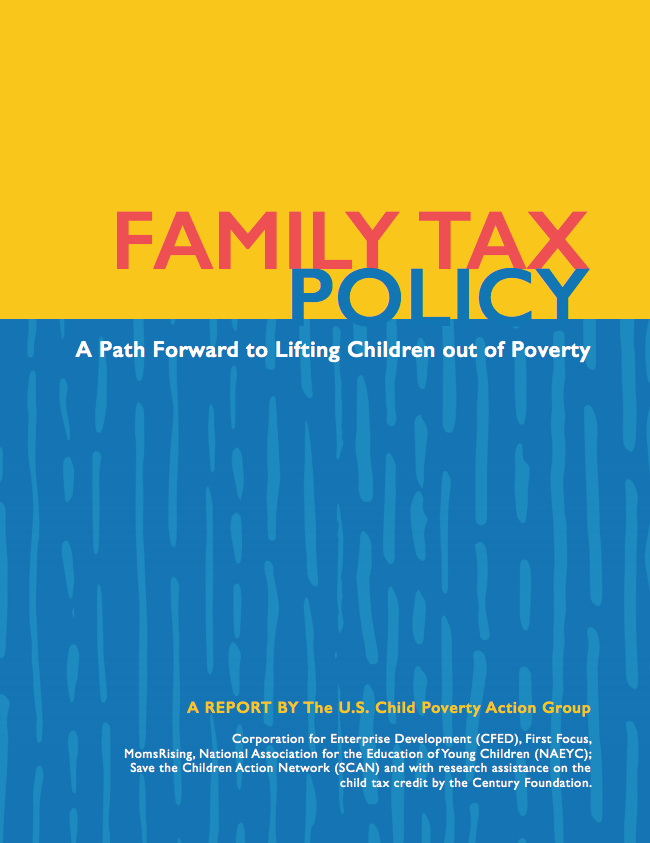Family Tax Strategies

You are here
Because of the benefits that high-quality early childhood education confers on individuals and society alike, investment in young children is—and must be!—a responsibility shared by families and the general public. The goal of helping low- and middle-income families with young children afford quality child care can be advanced by investing in direct subsidies, like those provided through the Child Care and Development Block Grant (CCDBG), and tax strategies, such as the Child and Dependent Care Tax Credit (CDCTC). NAEYC supports a vision of federal tax policy designed to ensure that federal revenues are sufficient to support investments in the critical programs that support children and families, and believes that strengthening the CDCTC is one way the federal tax code could better contribute to the important goal of affordability in child care as part of a solution for a broad and comprehensive financing strategy that delivers on the promise of early learning.
- What is the CDCTC?
- How does the CDCTC work?
- How does the CDCTC support families and children?
- How can you support the CDCTC?
- Highlighted Resources
Some states, such as Louisiana and Nebraska, have been making innovative choices to improve the quality of child care by establishing tax credits that reward educators who improve their teaching practices by increasing their qualifications and credentials—an idea that other states and the federal government could expand on.
What is the CDCTC?
The Child and Dependent Care Tax Credit (sometimes referred to as the child care tax credit) allows families to claim a credit of up to $1,050 (for one child) or $2,100 (for two) on their federal income taxes if they pay expenses for the care of qualifying individuals that enable parents to work, go to school, or actively look for work. It is the only tax credit in the federal tax code designed specifically to address child care affordability. The Child Tax Credit (CTC) is a different credit, with different purposes. They both have value and they both need to be expanded and strengthened to support our nation’s families.
How does the CDCTC work?
The CDCTC is a tax credit, not a tax deduction. The difference between a tax credit and a tax deduction is that a tax credit reduces taxes owed, while a deduction reduces taxable income. For the majority of families, a tax credit is better than a tax deduction—and a refundable tax credit is the best. That is because deductions, which are based on a family’s marginal tax rate, are worth more to families who make more, while a credit has the same value for everyone who can claim the full amount. In addition, when a credit is refundable (like the Earned Income Tax Credit and the American Opportunity Tax Credit), low-income families who do not earn enough to pay federal taxes can still benefit from the credit.
The CDCTC is currently non-refundable, which means that its benefits have not yet been extended to many of our nation’s lowest-income families. For those families who do claim the CDCTC, they receive the benefits once a year, after they file their taxes and count their child care expenses for the prior year.
How does the CDCTC support families and children?
The CDCTC, as it is currently constructed, can offset a portion of eligible families’ child care expenses. In 2016, an estimated 12.7 percent of families with children benefited from the CDCTC. Those families saw their taxes reduced by an average of $551.26. Of course, given the high cost of child care, the benefits of the CDCTC are far from adequate. There are other limitations as well: first, tax benefits are claimed when a tax return is filed–long after expenses have been paid, which is challenging particularly for families living paycheck to paycheck. And tax benefits for families don’t typically help to improve child care quality, support the child care workforce, or build supply in underserved areas. Subsidies, like those from CCDBG, which are paid on a regular basis to families and/or child care providers as child care costs are incurred, are most supportive of and helpful to low-income families, as well as to the foundation and infrastructure of the nation’s child care system itself.
How can you support the CDCTC?
There are many ways Congress could strengthen the CDCTC to better address the critical issue of affordability in child care. Given the possibilities of tax reform, however, and the desire to help lower- and middle-income families afford child care, NAEYC recommends strengthening the CDCTC in the following ways:
- Make the tax credit fully refundable
- Increase allowable expense limits to cover a greater proportion of families’ child care costs
- Increase the sliding scale to provide more assistance to middle-class families
- Change the payment structure so families receive the credit when they pay for the cost of care
How can you voice your support for improving the CDCTC? You can make your support—and NAEYC’s—known to your elected officials. And take the time to thank legislators who have shown leadership in this area, including Senators Angus King (I-ME) and Richard Burr (R-NC) and Representatives Stephanie Murphy (D-FL) and Kevin Yoder (R-KS). These four members of Congress introduced the bipartisan, bicameral Promoting Affordable Childcare for Everyone (PACE) Act, which NAEYC has endorsed, in order to expand and enhance the CDCTC and reflect the realities of modern-day child care costs. Let them and the Act’s many other cosponsors hear from you; and reach out to your own Senators and Representatives to ask them to become consponsors of the Act, if they aren’t already!
Highlighted Resources
- Statement on Child Care and Tax Policy, NAEYC
- Principles and Redlines for Child Tax Credit Expansion, Child Poverty Action Group
- Tax Reform Should Strengthen Existing Child Care Initiatives, First Five Years Fun
- Child Care Tax Strategies, National Women’s Law Center
